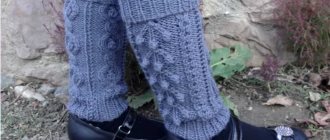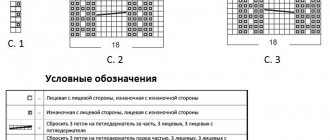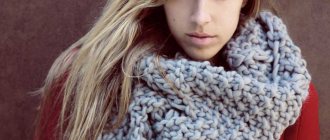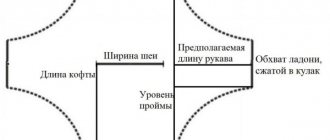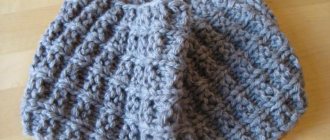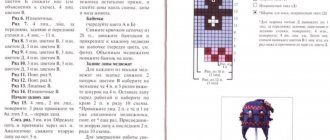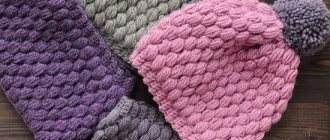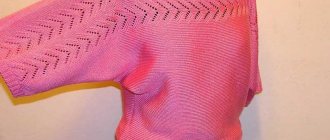Preparing to knit a scarf
For knitting, you must correctly determine the type of yarn. Fibers that are too heavy can simply turn elegant models into incomprehensible rags.
Basic symbols on the diagrams
Knitting has its own patterns, but there are so many of them. Very often one element can be displayed with different signs. For example, the front loop can be a dark square or just a stripe. Therefore, pay attention to the specific model and instructions - there should always be an explanation for each icon. Here is one example of circuit designation.
Selecting threads
The scarf can be knitted with different threads. Therefore, the best choice is the choice of a needlewoman. You can distribute depending on the warmth (more wool - warmer). Color preferences and fiber structure may vary.
Knitting a scarf “Romantic chic”
Look at the photo of the scarf. How perfectly this accessory complemented the young girl’s colorful dress. In this look, you can safely even go on a date or to a restaurant. That is why in our time, knitted scarves are no longer considered old-fashioned, but on the contrary, people try to wear them as often as possible in everyday life.
The finished size of the product is 94 cm by 188 cm. Prepare for work mohair yarn, straight knitting needles and for knitting in the round at number 3.5 and hook number 3. The openwork pattern of the scarf should be knitted according to the pattern. In purl. In stripes, all links, like capes, are knitted inside out. Complete the first to forty-second rows, and then repeat the last four rows. Immediately tie on the sides of the ornament as you did in the last six rows. Knitting of cloves is performed according to the second pattern. You should cast on twelve loops and knit them according to the second pattern, repeating from 1 to 8 rows.
Read
Knitting a curly sheep with knitting needles
Start knitting the product from the corner. Using straight knitting needles, string seven stitches, and then knit an openwork motif. After the number of buttonholes increases, move on to the circle. tool. When the fabric reaches 94 cm, you can close the loops. For cloves you need to string twelve sts. Then 1 r. knit faces. p., and then a row of purl. n. Continue knitting according to the proposed pattern. You need to knit eighty-three repeats to complete the product completely. Finally, close the links in a simple way.
Let's assemble our accessory. Sew the canvas on the sides of the main fabric, attaching it to the corner. To keep the seams neat, decorate them with one row of single crochets using a crochet hook. At this point the work is completely finished, the scarf with knitting needles is ready. The most important thing is that for beginning needlewomen this is the most profitable option for learning how to knit beautiful things.
Knitting patterns for scarves
Initially, perhaps, there were several schemes. For example, the Orenburg down scarf is the first association when mentioning the product. The corresponding scheme was assigned to him. It has been created for decades without a single deviation. The scheme suited him so well, so to speak. Today there are no special rules for making a scarf. If you want elastic, you want volume. No one deprived the right to choose a lace other than that of the Orenburg model. Various meshes, honeycombs and other patterns. All this well-being is diluted by an interesting border, which makes the product complete. Beginners can create a simple fabric and simply tie it with a lace border - and it will be perfect.
How to care for a knitted scarf?
In order for your scarf to last longer and delight you with its beauty, you need to unquestioningly follow the advice on caring for knitted items.
- It is necessary to wash only with special detergents; it is better to buy gels than powders, they are softer in composition and clean products even from the most delicate yarn.
- After washing, carefully stretch the scarf fabric on a horizontal, flat surface, securing it with pins every 5-7 cm, so the product will keep its shape for a long time. If you do not stretch the openwork scarf immediately before the first wear, you can say goodbye to a beautiful and even pattern - do not postpone this procedure.
We knit a scarf with our own hands: patterns and description
It is not difficult to make such products with your own hands, if the pattern allows it. There are also quite complex schemes; they are not recommended for beginners. It is necessary to go through the ladder from the first step and gradually approach more complex models. But knitting skill is a huge plus. The more you knit, the faster you get results. After all, the speed becomes faster and at the same time the loops are smoother.
Important! Doctors have noted the fact that seriously ill patients experience relief, and some even get better, deciphering the complex patterns of the canvas. The thing is that a person constantly counts loops and rows. This way he pushes aside sad thoughts, and this is very important at the time of illness.
Scarves can be of different shapes. Some are even close to scarves and fashionistas use them like this: they simply tie them around their necks. From the outside no one will think that this is a scarf. Regular square models, triangular ones, variations that are closer to bactus. New items are models in the shape of a semicircle. With small lace collars. How many categories open up, you just have to dig deeper. But the coolest and most elegant models are collected in this review with diagrams and descriptions. Let's try ourselves as a clothing designer and knit a scarf for ourselves and our loved ones.
Knitted thick scarf
A tight pattern can be made with knitting needles by anyone who knows how to knit knit stitches, purl stitches and how to make yarn overs.
After all, this is all you need to create an elegant scarf model. To work you will need:
- yarn Tosh DK 3 skeins (100% merino) 615 m;
- circular knitting needles 4.5 mm.
The gauge of this knitting is 16 stitches = 10 cm in stockinette stitch. The width of the model is 117 cm. You can make it wider or narrower if you wish. The model is knitted from the center of the base (triangle) and down. For the initial set you will need only 5 loops.
After knitting according to the pattern:
- 2 knits/pet, yarn over, 1 knit/pet, yarn over, 2 knit/pet.
- K/st until the end of the row (there will be only 7 loops and this is the wrong side of the fabric).
- Continue rows with yarn overs and between one knit stitch. As a result, due to two yarn overs in each front row, an increase of two loops will be obtained. This is how the scarf will gradually expand and increase in size. Continue knitting until the desired length (in this case, up to a length of 117 cm). The scarf will be dense due to the garter stitch pattern. It will look triangular due to two yarn overs that turn the work and expand it to the sides.
Product border : it is created using a 1*2 elastic band. On the front side there will be one front and two purl loops. Additions along the border make it with a slight wave.
On a note! The increases will be unnoticeable if you add loops between the front loops of the elastic band.
Knit 10 cm of elastic and bind off the loops. In the last row you will get an elastic band of 1*3 (this is achieved by gradual additions). Then you can close the loops according to the fabric pattern. An elegant and thick scarf is ready and can be worn with jackets, cardigans and coats.
Scheme of an openwork scarf with knitting needles
Anyone who has not knitted will not understand that each pattern has its own ideal pattern.
If the braids are better visible in gray tones of the yarn, then this pattern is definitely better in the rich blue color. To work you will need:
- Alize Real yarn (100 g contains 480 m);
- knitting needles number 2;
- hook 2 mm.
The work is done not only with knitting needles, but a crochet hook helps a little after finishing, because it is this that creates the last air fibers. The openwork from pattern A is knitted with knitting needles, but only one half of the scarf is indicated. The second one is knitted symmetrically and immediately. Therefore, you need to cast on the knitting needles twice as many stitches as shown in the diagram. This pattern is knitted faster, despite the fact that there are more rows. The thing is that the rows will be shorter at first, then they will gradually expand due to the central loops and yarn overs. Next, we move on to pattern B and knit the larger elements of the openwork fabric. A hook will help you finish knitting. You need to follow this scheme for closing loops :
- several loops together;
- 6 air loops.
The pattern of the canvas itself will tell you. But in the end you should end up with such a beautiful weave.
You can finish the row with knitting needles, but it will be long and difficult.
Don’t be discouraged if you don’t like the canvas after finishing the work. Like all knitted items, the product needs to be wet and stretched. This way all the loops will dry and take the correct position. And you will get a product like in the photo. Such beauty, it’s a pity to even crush it.
Knitted Scandinavian scarf
The model of the Scandinavian scarf is distinguished by its shape - it is almost a triangle. It is obtained by yarn overs or decreases with bends.
To work you will need:
- 200–300 grams of yarn with the addition of acrylic;
- knitting needles of the appropriate size, depending on the thickness of the yarn.
The model uses a checkerboard pattern, stockinette stitch and purl stitch. These are completely different elements, but together they create something unusual. Therefore, with them it may well turn out to be a Scandinavian scarf.
A very bright color was chosen for the canvas, and so the patterns began to play in a new role. The pattern shows that you can knit in different directions. The result will be one canvas.
Use knitting needles to cast on the desired number of stitches. Next, make decreases in one row, two at a time. Do this every second person (or every fourth in the general sense). But at the same time make increases on the opposite side, in the same way.
Knitted down scarf
A very interesting model of a down scarf. Beginners will probably think, why complicate everything - it’s just a square canvas. In fact, a scarf is not that easy to knit. Especially this model. After all, knitting occurs in corners and in different directions. It's easy to get confused, but that's not what this description is for. So, let's try and figure it out together.
To work you will need:
- goat fluff 90 g;
- contrast thread;
- knitting needles No. 2;
- pins or loop holders.
The diagram produces several corners that will need to be connected together using central loops.
Using this analogy, you need to create another angle. To do this, you will need to knit one side of the border to the desired length.
Next, attach the second diagram of the model to the work.
This pattern will run through the center of the scarf, between the three sides of the border. For it, you will initially need to cast on loops from one of the inner sides of the border. Work in the opposite direction from the border and join the right and left sides on each row, simply knitting the stitches together. Once the required length is formed, move to the border, which will be the fourth side of this scarf. Attention - the diagram should form a square in the center. All loops must be counted and knitted with the same density. The last border is knitted very similarly to the middle of the scarf, only the loops are caught on one side (from pattern number two).
Knitted bactus scarf
It can be called today “the most fashionable scarf.”
To work you will need:
- medium thickness yarn;
- knitting needles No. 3.
For bactus you need only two schemes:
- facial surface;
- purl stitch.
Three steps in work:
- Starting work from a corner. Cast on three stitches with knitting needles. Knit 6 rows in stockinette stitch. In the last row in the last loops, add one loop. Change the pattern to purl stitch. And again 6 rows and again adding 1 loop. By analogy, create 40 cm.
- Step for obtaining a rounded profile. In each even row, increase 1 stitch on the inner side. From the outside (this one is opposite the increases from the first stage), make decreases using the same technology. Do this exactly 30 cm.
- At the beginning of every 6th row, bind off 4 loops. At the same time, create increments along the loop: in an even row - at the end, in an odd row - at the beginning. Close when the desired length is reached.
Openwork scarf with knitting needles
A scarf knitted with an openwork pattern is a favorite accessory of a modern woman. For those for whom this kind of knitting is new, it is better to choose a clear and readable pattern.
- We start knitting with 64 loops. First we go through the front rows, rows 2-4-6, etc.
- We knit the edge in the third row, then 4 stitches, yarn over, double yarn over and yarn over. Duplicate 5 times.
- Next we knit in accordance with the pattern, which consists of rhombuses. We knit the last 12 rows with regular knit stitches.
Some magazines offer patterns for the openwork part and canvas - when ready, the parts are sewn together, which creates a seam that is noticeable when wearing the scarf. This option is unacceptable, especially on light scarves, so it is better not to resort to prefabricated knitting patterns. It will be easier for novice craftswomen to navigate when knitting a product from above; in this case, the pattern can simply be turned over.
Popular varieties
There are an endless number of types of shawls that can be knitted. The main varieties for those who are just learning needlework:
- Beautiful triangular shawl. It is knitted according to the principle of a regular large scarf - from a wide edge to a narrow one or vice versa.
- Rectangular. Knitted in the form of a figure with equal or different sides. Finishing along the edges creates the effect of completeness of the product and does not allow the shape to change during wear.
- Semicircular shawl. Not the most popular model, a little more difficult to make than a regular triangle. The addition of loops does not occur evenly, but in sectors to create an even semicircle along the edge of the product.
- Crescent scarf. Due to the elongated ends, it fits neatly around the neck, leaving tails for a beautiful knot.
- In the form of a wave. It looks very impressive due to the bending of the canvas. Additionally, the wavy line is emphasized by a pattern of segmented yarn in a gradient color.
- Shawls in the form of a simple cape of different shapes. Easy-to-make patterns that allow you to realize any fantasies using interesting patterns and knitting methods.
- Stole. This is a large scarf or handkerchief that a petite girl can easily wrap herself in. It is often worn in the cool season, covering the shoulders.
- Bactus. These products come from Scandinavian culture. Initially, it was a warm, bright scarf, which in modern times has turned into a fashion accessory.
Bactus
In wave form
Stole
Semicircular
Rectangular
crescent scarf
Triangular
All these models will be within the capabilities of beginning craftswomen. The shawl is knitted using knitting needles according to patterns and descriptions. For work, easy-to-execute openwork patterns are used. However, for experienced knitters it is no longer enough to make a simple scarf. For such skillful hands, they came up with more complex and interesting models that look like a separate type of creativity:
- Shawl "Cornflowers". Consists of many beautiful flowers and petals. The shape of the product is slightly reminiscent of a triangle, but the airy patterns at the numerous ends give the scarf a fantasy look. These openwork shawls are knitted with cornflower blue knitting needles and blue threads.
- Model "Marshmallow". The shape of the product also defies description due to the infinity of pattern transitions from one level to another.
- “Triana”, which is knitted in the form of a triangular shawl. The result is a cape made of multi-colored stripes with transitions of patterns and colors.
- Orenburg down scarf, valued for its lightness. It is believed that only the original product is so thin and delicate that it can pass through the ring.
- "Twinity." The shape resembles a bactus, only much larger. Openwork patterns, light warm threads – and here is a beautiful, unusual accessory in the fashionista’s collection.
- Shawl "Marianne". Appeared as a development of the idea of a knitted collar. Currently, the pattern is used as the basis for making an entire model.
Many models are called differently only because they are made with personalized patterns. Meanwhile, their styles are no different.
Cornflowers
Marshmallow
Marianne
Orenburg shawl
Twinity
Triana
Knitting bactus, the work of our readers
Bactus knitting Impatiens from Elena Vasilyeva
Baktus “Touch-me-not”, yarn adelia Mia print 307/100, 3 knitting needles, a little more than 2 skeins were used. I found the description on the Internet. Simple in execution, but very stylish. A great accessory for warm autumn. Bactus knitting patterns: Description of bactus
Read more…
Bactus knitting Flower fantasies. Work by Alexandra Milichenko
Bactus “Floral fantasies”. A few years ago I saw a similar bactus on the Internet, for a long time I hatched the idea and selected yarn. I settled on sectional knitting yarn Nazar-Rus “Orion” (40% six, 45% acrylic, 15% polyamide) 200 m per 100 g. Knitting needles number
Read more…
Knitted bactus Playful from Olga Mukhina
Good afternoon I haven’t posted anything for a long time, but I got in touch with this bactus in one go! For the work we used 4mm knitting needles, pekhorka crossbred Brazilian semi-wool thread, 500m in 100g. In terms of consumption, I knitted exactly 1 skein. Czech
Read more…
Shawl - bactus knitted Impatiens from Tatyana
Good afternoon everyone. I was walking around the Internet and came across this miracle. And I wanted such a bactus so much that I immediately started knitting. Matching threads were Alize Agnora gold batik
Read more…
How to knit bactus with knitting needles, description from Saule Vagapova
A convenient accessory is bactus. It is not difficult to knit, in garter stitch, from left to right, i.e. across. Expansion occurs due to increases on one side and mirror decreases on the other. The size of my bactus is 37 cm x 170 cm. Merino Batik yarn,
Read more…
Shawl - bactus knitted, simple model
My new work is a shawl. Length 2m. Knitted from Alize Angora Gold Simli and Alize Angora Gold yarns. It took one and a half skeins of each yarn, knitted in garter stitch, alternating 2 ribs of each color. Has a shape
Read more…
We knit bactus with knitting needles and tassels
You will need: yarn (100% wool, 300m/100g) – 100g purple and 100g black, knitting needles No. 2.5. Garter stitch: knit. and out. rows - only faces. loops. Cast on 3 stitches and knit in garter stitch
Read more…
Bactus scarf-kerchief knitted, master class!
Today, needlewomen knit bactus - a triangular scarf-kerchief in different ways: crocheted, knitted, on a fork... But initially bactus is knitted with garter stitch. It can be worn as a shawl, scarf or handkerchief. It all depends on the size of the knitted bactus. Master Class
Read more…
